|
Third Battle of Winchester, Civil War History
Names: Battle of Winchester; Third Battle of Winchester;
Battle of Opequon; Battle of Opequon Creek
County: Frederick, Virginia, and City of Winchester
Campaign: Sheridan's Valley Campaign; 1864 Shenandoah Valley Campaigns
Date(s): September 19, 1864
Principal Commanders: [C] Lt. Gen. Jubal Early; [U] Maj. Gen.
Philip Sheridan
Forces Engaged: [C] Four divisions (Gordon, Rodes, Ramseur, Breckinridge/Wharton),
two cavalry divisions (Fitz Lee, Lomax), about 15,200; [U] Three infantry corps (Wright, Emory, Crook), cavalry corps (Torbert),
about 39,236.
Casualties: [C] 3,611 (226k/1,567w/1,818m&c); [U] 5,018 (697k/3,983w/338m).
Result(s): Union victory
| Third Battle of Winchester, Virginia |
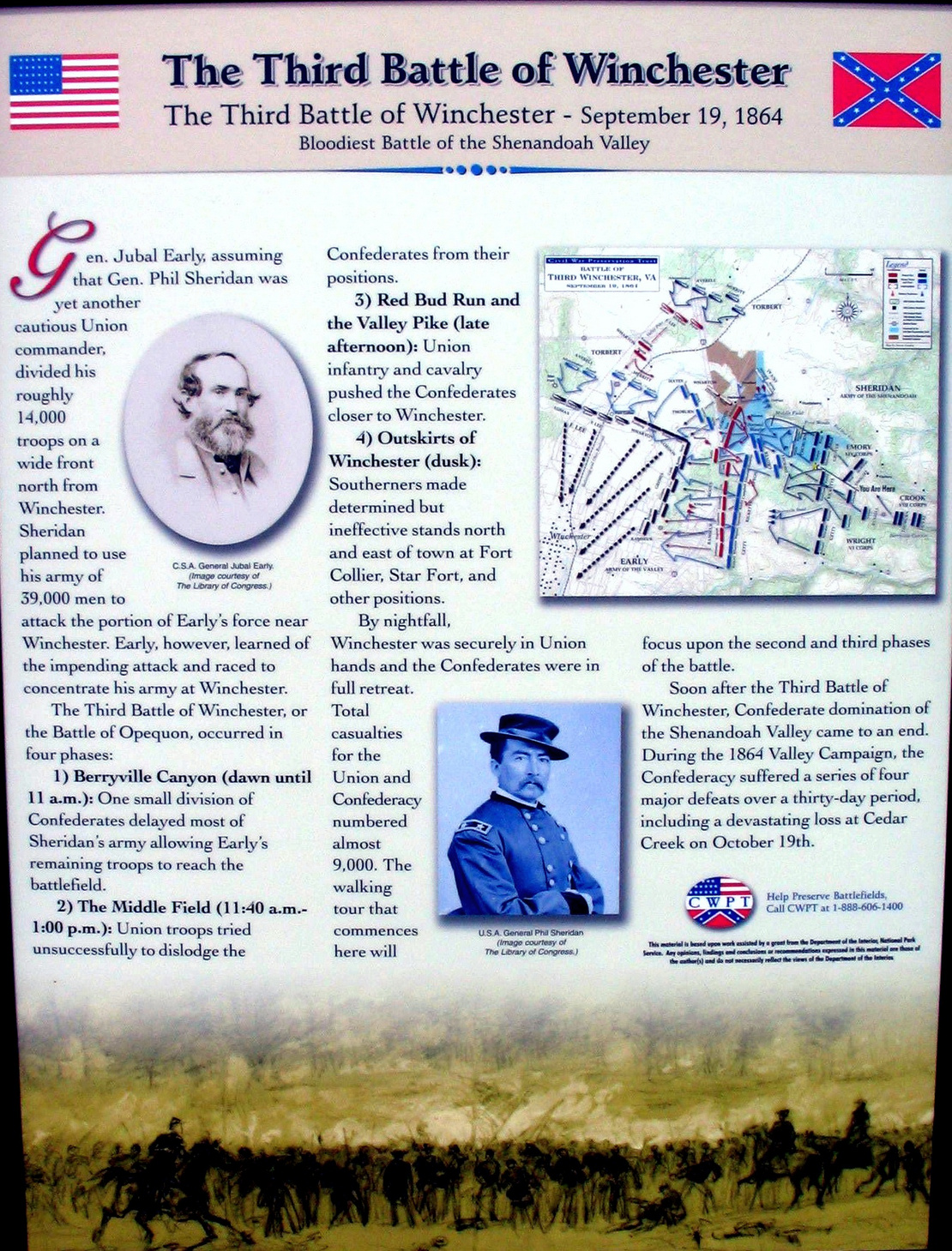
|
| Civil War History |
| 3rd Battle of Winchester, Virginia, Civil War Map |
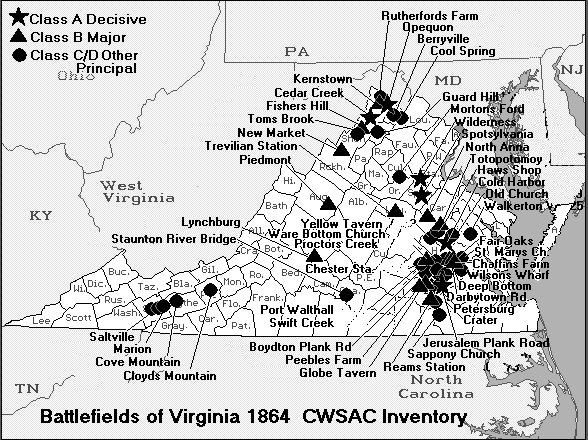
|
| (Click to Enlarge) |
Significance: Opequon or Third Winchester (fought 19 September 1864) was the largest and
most desperately contested battle of the Civil War in the Shenandoah Valley, resulting in more than 9,000 casualties. The
battle was a turning point of the war in the Valley, marking the rise of Sheridan and the decline of Confederate power. Sheridan
defeated the Confederate army again three days later at Fisher's Hill (22 September), forcing it to retreat up the Valley
to near Waynesboro. The CS army of Lt. Gen. Jubal A. Early suffered about 23 percent casualties. Casualties for the larger
Union army under Maj. Gen. Philip Sheridan exceeded 5,000, nearly 20 percent. The Union XIX Corps sustained 40 percent casualties
(2,074 men) and lost every regimental commander during its assaults on the Middle Field and Second Woods. The most severe
fighting and casualties occurred in the large parcel east of I-81, north of rte. 7, west of rte. 656, and south of rte. 661.
The Middle Field ranks with some of the most sanguinary fields of the Civil War, witnessing more than 3,000 casualties. CS
general Robert E. Rodes and US general D. A. Russell were both killed within a few hundred yards of the Dinkle Barn site at
the entrance to Winchester Mall.
Description of the Battle: The 3rd Battle of Winchester,
part of Sheridan's Valley Campaign, was Grant's response to Early's relentless pressure throughout the Shenandoah Valley.
Sheridan's Valley Campaign [August-October
1864] witnessed the following battles: Guard Hill – Summit Point – Smithfield Crossing – Berryville – 3rd Winchester – Fisher's Hill – Tom's Brook – Cedar Creek.
US Advance (19 September): Maj. Gen. Philip Sheridan's army advanced
from the vicinity of Berryville on the Winchester-Berryville Pike about 0200 hours, 19 September 1864. At earliest light,
Brig. Gen. James Wilson's cavalry division crossed the Opequon at Spout Spring and advanced through a defile known as Berryville
Canyon, followed by the US infantry (VI Corps, XIX Corps, and Crook's corps). At the canyon's mouth the cavalry met the first
elements of Maj. Gen. Stephen Ramseur's CS division and drove them back on their supports. Johnston's brigade deployed across
the pike and held back the Union advance, while the rest of the division came into line to cover the Berryville Pike and Senseny
Road farther to the south. The US cavalry launched several mounted and dismounted charges, driving the CS infantry back about
150 yards to the vicinity of the Dinkle Barn. Here Ramseur stiffened his defense with artillery, and the US cavalry withdrew
as its infantry began to deploy. Wilson's division moved to cover the US left flank where it remained for the rest of the
battle.
| Winchester, September 19, 1864, Civil War Map |
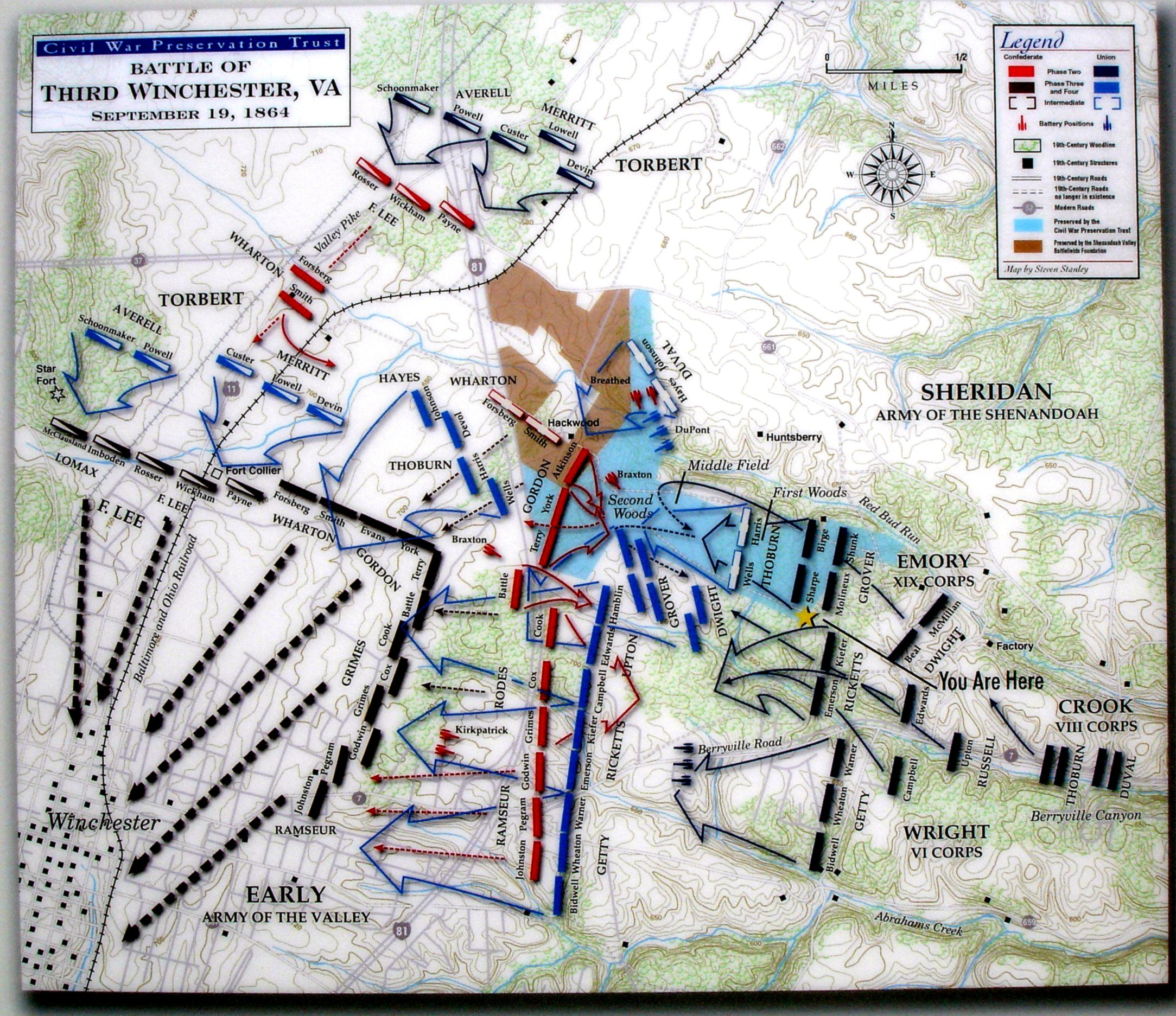
|
| Third Battle of Winchester, Virginia |
Cavalry Action: About 0200 hours Brig. Gen. Wesley
Merritt's cavalry division of three brigades (Custer, Devin, Lowell) advanced toward Seiver's and Locke's fords from the vicinity
of Berryville. Their crossings were resisted by Brig. Gen. John McCausland's cavalry brigade dismounted behind barricades.
The Reserve brigade (Lowell) pushed across at Seiver's Ford against fitful opposition. Custer's brigade met heavier resistance
at Locke's Ford and made several mounted charges before securing a foothold on the western bank. By 0800 hours both wings
were across the creek, but the cavalry did not advance for several hours. About 1030 hours, McCausland's skirmishers withdrew,
and Merritt's division moved cautiously forward. Waiting for them was Wharton's infantry division about a mile west of the
fords, deployed across the roads in woods and behind stone fences. About 1100 hours, the US cavalry began testing the CS defenses
with skirmishers and artillery. Custer launched one mounted attack but was quickly repulsed. About noon, Sheridan's main infantry
attack was underway, and Wharton's division withdrew to cover the CS left flank on the Valley Pike north of Winchester. Merritt
continued forward along Charles Town Road. Custer followed the line of the Winchester & Potomac Railroad. About 1400 hours
Merritt's division converged with Averell's cavalry division on the Valley Pike near Stephenson's Depot. (See phase seven.)
Deployment of US Infantry: In the meantime, the Union
infantry bogged down in the narrow confines of Berryville Canyon, dashing Sheridan's hopes of quickly taking Winchester and
defeating the CS army in detail. Maj. Gen. Horatio Wright's VI Corps of three divisions (Getty, Ricketts, Russell) emerged
from the canyon in order. Getty's division deployed south of the pike with its left flank resting on Abrams Creek. Ricketts'
division formed north of the pike on Getty's right and extending to Redbud Run. Russell's division was held in reserve. The
XIX Corps of two divisions (Dwight and Grover) did not begin crossing until after 0900 hours and eventually deployed north
of the pike into the First Woods, connecting with Ricketts' right. Sheridan established his headquarters near the Berryville
Pike, probably south of the road on the Eversole Farm.
As the US infantry deployed, the CS batteries opened a furious fire from behind
the Dinkle Barn. Union batteries swung into action on both sides of the pike to engage the CS guns.
In the meantime, Lt. Gen. Jubal Early concentrated his scattered divisions.
Rodes' division, marching from near Stephenson's Depot, deployed to the left and rear of Ramseur's division in the West Woods.
Gordon's division extended the line across the Hackwood Farm to Redbud Run. Wharton's infantry and Fitz Lee's cavalry division
drew a line across the Valley Pike north of town near Stephenson's Depot. CS batteries deployed on high ground along Baker
Lane north and south of the West Woods, and north of Redbud Run. Skirmishing continued along Ramseur's front.
| 3rd Battle of Winchester Detailed Civil War Map |
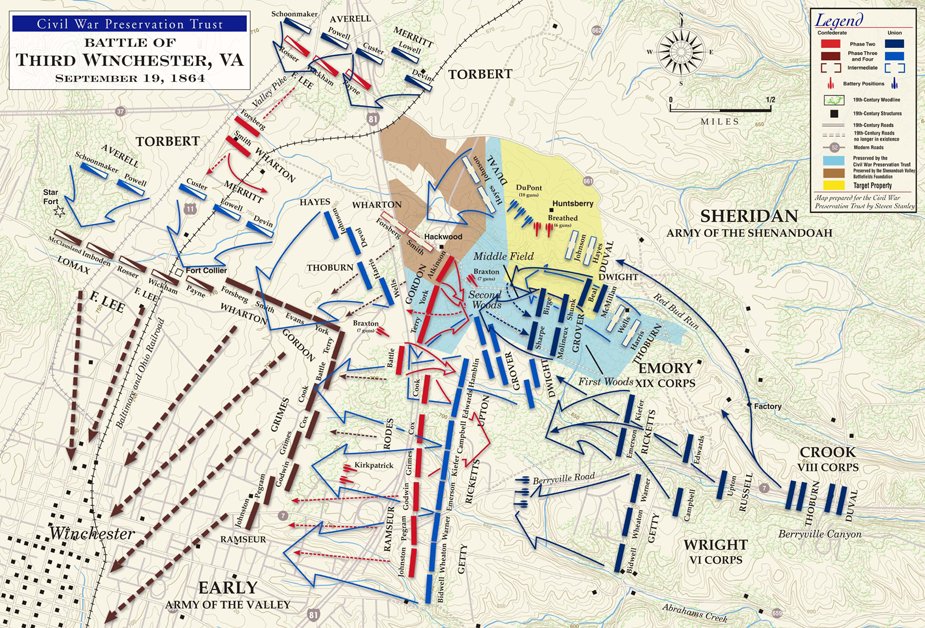
|
| Third Battle of Winchester |
| Third Battle of Winchester Map |
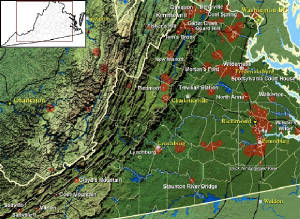
|
| 3rd Battle of Winchester, aka Battle of Opequon Map |
Fighting in Middle Field: At
1140 hours, a US signal gun boomed and Grover's division of four brigades (Birge, Molineux, Sharpe, and Shunk) launched its
attack from the First Woods across Middle Field toward the Second Woods behind which Gordon's division waited. CS horse artillery
north of Redbud Run played havoc with the flanks of Grover's attacking line. Birge's brigade reached the woods, driving back
skirmishers, but then came up against Gordon's main line and were staggered. Sharpe's brigade came up on Birge's left, and
the fighting became desperate. The Confederate line broke, falling back across the Hackwood property. Seven CS cannon in the
Hackwood Lane fired canister pointblank into the US attackers, throwing them back. Gordon now launched a counterattack with
two brigades, driving Birge and Sharpe out of the Second Woods and back across Middle Field. Grover ordered Molineux to advance
and plug the gap that had opened between Birge and Sharpe. The firing was so intense that Molineux's flanks seemed to ``melt
away.'' Shunk's brigade was thrown forward to bolster the wavering Union line, coming in on Molineux's right rear. Shunk closed
to within sixty yards of the CS line in the Second Woods. The two lines delivered pointblank volleys into each others' ranks.
Gordon again counterattacked, and the Union attack collapsed. The wreckage of Grover's division went streaming back across
the Middle Field to the safety of the First Woods. The CS horse battery (Breathed) north of Redbud Run again worked execution
among the retreating division. Every regimental commander in Grover's division was killed or wounded; casualties totaled nearly
1,500. Beal's brigade of Dwight's division deployed in the treeline at the east end of the Middle Field and advanced into
``that basin of Hell'' to stem the retreat. Gordon's men waiting along the treeline of the Second Woods laid down a murderous
fire. The Union brigade did not reach within 200 yards of the Second Woods before being pinned down. They expended all of
their ammunition before retreating back to the First Woods. The 114th New York suffered casualties of 60 percent (188 of 350
effectives). McMillan's brigade, personally directed by Corps commander Maj. Gen. William Emory, advanced. They reached a
shallow ravine about 200 yards from the Second Woods, where two regiments (8VT and 12CT) clung on for nearly two hours. By
1300 hours, the main thrust of the XIX Corps attack was blunted and its ranks decimated. By 1400 hours, firing on this end
of the field sputtered out from sheer exhaustion.
Fighting Near Dinkle Barn: At 1140 in conjunction with the XIX
Corps' advance on the right, Getty's and Ricketts's divisions of the VI Corps launched their attack against Ramseur's line,
which was positioned on high ground, stretching from the Dinkle Barn south behind Abrams Creek. Ricketts' division on the
right was ordered to guide its attack on the Berryville Pike, which takes a sharp jog to the left in front of the Dinkle Barn.
As they advanced, a gap widened between the VI Corps and the XIX Corps on the far right. Keifer's and Emerson's brigades ruptured
the Confederate center at the Dinkle Barn and moved to capture a battery of artillery in front of the West Woods. Ramseur's
left flank now gave way and Confederates began to drift back toward Winchester.
| 3rd Battle of Winchester Battlefield Map |
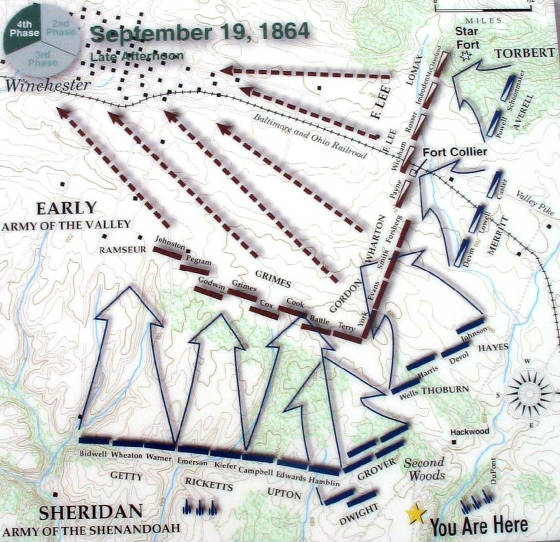
|
| Collapse of the Confederate Line |
Rodes's Counterattack: Just as Ramseur's left flank gave way
from the Union attacks, Maj. Gen. Robert E. Rodes brought his division forward from its protected position in the West Woods.
About 1330 he launched a devastating counterattack into the gap that had opened between the VI and XIX Corps. Battle's Alabama
brigade ``came out of the woods like a whirlwind,'' crushing Ricketts's division, which formed the right flank of the VI Corps.
About this time, General Rodes was killed by shrapnel. He fell somewhere along the woods line. Union soldiers streamed back
along the Berryville Pike, while two US batteries astride the pike tried to slow the CS assault. From his command post on
Eversole's Hill, Sheridan and Wright witnessed the disaster. Sheridan immediately committed his reserves to stave off certain
defeat; this was David A. Russell's division of three brigades (Campbell, Upton, and Edwards). Campbell advanced his brigade
astride the Berryville Pike with Edwards' brigade to his right. General Russell, directing these maneuvers, was mortally wounded.
The two brigades struck Battle's attackers head-on and stalled them in the ravine from which they had emerged and drove them
back on their supports at the edge of the West Woods--the rest of Rodes' division. Upton's brigade came in on Edwards' right
advancing from the edge of the Second Woods. The two divisions--Rodes' and Russell's--closed, exchanging murderous volleys.
Upton's impetuous charge stopped the CS counterattack and drove it back into the West Woods. Russell's division was then withdrawn
out of range to regroup. Wright called Upton's attack the turning point of the battle.
Cavalry Action: Concurrent with the above events, there was cavalry
fighting along the Valley Pike north of Winchester. About 0500 hrs. the Union cavalry division of William Averell crossed
the Opequon near Darkesville and moved to the Valley Pike, steadily pushing back the 23rd Virginia Cavalry, which fought a
delaying action back to Bunker Hill. There the 23VA were reinforced by the 62nd Virginia mounted infantry.
About 10 o'clock, Union cavalry attacked at Bunker Hill, forcing the CS cavalry
to retire. Averell continued pushing south on the pike to link up with Merritt's division about 1400 hours, near Stephenson's
Depot. South of the old Charles Town road, the Confederate cavalry units were stiffened by Smith's infantry brigade (Wharton's
Division). About 1330, Devin's brigade arrived on the road to the depot. About one mile south of the depot, it encountered
McCausland's brigade drawn up in line of battle and attacked, driving the Confederates back in confusion. The 23VA cavalry
and the 62VA mounted infantry attacked the Union flank disrupting the charge. McCausland and Smith retired one mile to the
lightly entrenched line at near Collier Redoubt where they were reinforced by Fitz Lee's two brigades (Wickham and Payne)
and Wharton's infantry division. Maj. Gen. Fitzhugh Lee fell wounded, during the fighting south of Stephenson's Depot. The
Union cavalry deployed five brigades in line of battle, stretching from the railroad west toward the ridge near the intersection
of the Valley Pike and Welltown Road.
| Third Winchester Battlefield Tour Map |
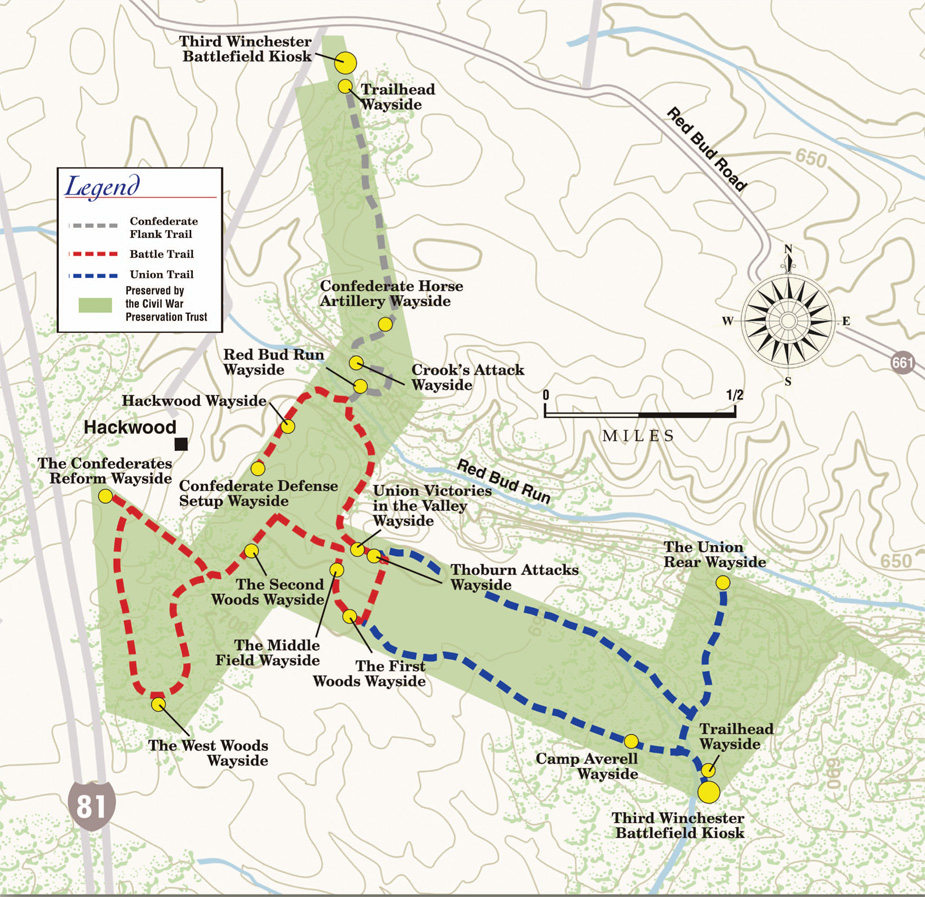
|
| (Click to Enlarge) |
Crook's Flank Attack: About 1300 hours, Sheridan directed Crook's corps of two divisions (Thoburn and
Duval) to advance from its reserve position near Spout Spring. The divisions marched to near the ``Factory'' on Redbud Run,
where they split up. Thoburn's division moved west on the south bank of Redbud into the First Woods to relieve the XIX Corps.
Duval's division crossed the run and turned west accompanied by the artillery of Capt. Henry DuPont. Duval's division deployed
near the Huntsberry House. DuPont unlimbered 18 guns on what has been named DuPont Hill, opposite Gordon's flank in the Second
Woods and opened fire. Crook now ordered Duval's division forward into a ``wall of flame.'' They swept across Redbud Run at
the Hackwood House, turning Gordon's flank and advancing against Wharton's line, stretching from Collier Redoubt east. About
this time, Thoburn's division charged out of the First Woods into the Middle Field. This two-pronged assault forced Gordon
to abandon the Second Woods and align himself with Breckinridge to his left rear. The CS line was now drawn into a compact
L-shape, anchored by cavalry at Star Fort. Wharton's division faced north. Gordon's division made the turn of the L and Rodes'
and Ramseur's divisions extended the line south to Abrams Creek.
Collapse of CS Line: With the success of Crook's attack on the right, Sheridan ordered a general advance
against the constricted CS position on the plateau just north and east of the town. The Confederates were posted behind stone
fences, rail barricades, and in shallow earthworks constructed in 1862. They could retreat no farther without losing organization
in the streets of Winchester. As the Union advance closed from east and north, firing became fierce and desperate. The massed
artillery of both sides fired case shot and canister. General Sheridan rode forward to the battle lines to urge his troops
forward. About 1530 hours, as the infantry fighting reached a crescendo, Averell and Merritt advanced their cavalry divisions
astride the Valley Pike, first at a walk and then at a thundering gallop. They swept over the CS line at Collier Redoubt driving
back the CS cavalry on the low ground below Star Fort. Schoonmaker's brigade of Averell's division repeatedly attacked Munford's
cavalry at Star Fort, eventually overrunning the work. The CS infantry withdrew to another
line about 150 yards to the rear but the damage was done. The sound of Union cavalry pounding in their rear spread panic all
along the Confederate line, and soldiers began streaming to the rear and ``whirling through Winchester.'' Wharton's and Gordon's
divisions seemed to disintegrate. Seven Federal horseman captured Confederate battle flags, each earning a Medal of Honor.
Rodes's division (commanded now by Grimes) performed the difficult maneuver of ``changing front'' to the north to stop the
onrushing US cavalry. Early's army retreated in disorder.
Aftermath: General Early fashioned a defensive line
at Kernstown (probably at Pritchard's Hill and behind Hoge's Run) which saved his wagons and most of his artillery. Cavalry
and elements of the VI Corps probed this makeshift CS defense as night fell, but the US forces were too disorganized by success
to mount an effective pursuit. After dark, the CS army withdrew up the Valley Pike to Fisher's Hill south of Strasburg. Gen.
Sheridan established his headquarters in Winchester at the home of Lloyd Logan. Casualties were so severe that nearly every
sizeable structure in Winchester served as a hospital after the battle. Advance to 3rd Battle of Winchester: A Civil War History.
(Sources and related reading below.)
Recommended
Reading: From Winchester to Cedar Creek:
The Shenandoah Campaign of 1864. Amazon.com
Review: Virginia's Shenandoah
Valley was a crucial avenue for Confederate armies intending to invade Northern states during the Civil
War. Running southwest to northeast, it "pointed, like a giant's lance, at the Union's heart, Washington, D.C.,"
writes Jeffry Wert. It was also "the granary of the Confederacy," supplying the food for much of Virginia. Both sides long
understood its strategic importance, but not until the fall of 1864 did Union troops led by Napoleon-sized cavalry General
Phil Sheridan (5'3", 120 lbs.) finally seize it for good. He defeated Confederate General Jubal Early at four key battles
that autumn. Continued below…
In addition
to a narrative of the campaign (featuring dozens of characters, including General George Custer and future president Rutherford
B. Hayes), this book is a study of command. Both Sheridan
and Early were capable military leaders, though each had flaws. Sheridan tended to make mistakes before battles, Early during them.
Wert considers Early the better general, but admits that few could match the real-time decision-making and leadership skills
of Sheridan
once the bullets started flying: "When Little Phil rode onto the battlefield, he entered his element." Early was a bold fighter,
but lacked the skills necessary to make up for his disadvantage in manpower. At Cedar Creek, the climactic battle of the 1864
Shenandoah campaign, Early "executed a masterful offensive against a numerically superior opponent, only to watch it result
in ruin." With more Confederate troops on the scene, history might have been different. Wert relates the facts of what actually
happened with his customary clarity and insightful analysis.
Recommended Reading: LAST BATTLE OF WINCHESTER,
THE: Phil Sheridan, Jubal Early, and the Shenandoah Valley Campaign, August 7 - September 19, 1864. Description: The Last Battle of Winchester: Phil Sheridan, Jubal Early, and the Shenandoah
Valley Campaign, August 7 - September 19, 1864 is the first serious study to chronicle the Third Battle of Winchester. The
September 1864 combat was the largest, longest, and bloodiest battle fought in the Shenandoah Valley. Continued below...
What began about daylight did not end until dusk, when the victorious Union
army routed the Confederates. It was the first time Stonewall Jackson's former corps had ever been driven from a battlefield,
and their defeat set the stage for the final climax of the 1864 Valley Campaign. The
Northern victory was a long time coming. After a spring and summer of Union defeat in the Valley, Lt. Gen. Ulysses S. Grant
cobbled together a formidable force under Phil Sheridan, an equally redoubtable commander. Sheridan's task was a tall one:
sweep Jubal Early's Confederate army out of the bountiful Shenandoah, and reduce the verdant region of its supplies. The aggressive
Early had led the veterans of Jackson's Army of the Valley District to one victory after another at Lynchburg, Monocacy, Snickers
Gap, and Kernstown. Five weeks of complex maneuvering and sporadic combat
followed before the opposing armies ended up at Winchester, an important town in the northern end of the Valley that had changed
hands dozens of times over the previous three years. Tactical brilliance and ineptitude were on display throughout the day-long
affair as Sheridan threw infantry and cavalry against the thinning Confederate ranks and Early and his generals shifted to
meet each assault. A final blow against Early's left flank finally collapsed the Southern army, killed one of the Confederacy's
finest combat generals, and planted the seeds of the victory at Cedar Creek the following month. Scott
Patchan's vivid prose, which is based upon more than two decades of meticulous research and an unparalleled understanding
of the battlefield, is complimented with numerous original maps and explanatory footnotes that enhance our understanding of
this watershed battle. Rich in analysis and character development, The Last Battle of Winchester is certain to become a classic
Civil War battle study. About the Author: A life-long student of military
history, Scott C. Patchan is a graduate of James Madison University in the Shenandoah Valley. He is the author of many articles
and books, including The Forgotten Fury: The Battle of Piedmont (1996), Shenandoah Summer: The 1864 Valley Campaign (2007),
and Second Manassas: Longstreet's Attack and the Struggle for Chinn Ridge (2011). Patchan serves as a Director on the board
of the Kernstown Battlefield Association in Winchester, Virginia, and is a member of the Shenandoah Valley Battlefield Foundation's
Resource Protection Committee.
Recommended Reading: The Shenandoah Valley Campaign of 1864 (McFarland
& Company). Description: A
significant part of the Civil War was fought in the Shenandoah Valley of Virginia, especially in 1864. Books and articles
have been written about the fighting that took place there, but they generally cover only a small period of time and focus
on a particular battle or campaign. Continued below...
This work covers
the entire year of 1864 so that readers can clearly see how one event led to another in the Shenandoah Valley and turned once-peaceful
garden spots into gory battlefields. It tells the stories of the great leaders, ordinary men, innocent civilians, and armies
large and small taking part in battles at New Market, Chambersburg, Winchester, Fisher’s
Hill and Cedar Creek, but it primarily tells the stories of the soldiers, Union and Confederate,
who were willing to risk their lives for their beliefs. The author has made extensive use of memoirs, letters and reports
written by the soldiers of both sides who fought in the Shenandoah Valley in 1864.
Recommended
Reading: The
Shenandoah Valley Campaign of 1864 (Military Campaigns of the Civil War) (416 pages) (The University of North
Carolina Press). Description: The 1864 Shenandoah Valley Campaign
is generally regarded as one of the most important Civil War campaigns; it lasted more than four arduous months and claimed
more than 25,000 casualties. The massive armies of Generals Philip H. Sheridan and Jubal A. Early had contended for immense
stakes... Beyond the agricultural bounty and the boost in morale to be gained with its numerous battles, events in the Valley
would affect Abraham Lincoln's chances for reelection in November 1864. Continued below...
The eleven
essays in this volume reexamine common assumptions about the campaign, its major figures, and its significance. Taking advantage
of the most recent scholarship and a wide range of primary sources, contributors examine strategy and tactics, the performances
of key commanders on each side, the campaign's political repercussions, and the experiences of civilians caught in the path
of the armies. The authors do not always agree with one another, but, taken together, their essays highlight important connections
between the home front and the battlefield, as well as ways in which military affairs, civilian experiences, and politics
played off one another during the campaign.
Recommended
Reading: The Official Virginia Civil War Battlefield Guide. Review: This is one of the most useful guides I've ever read.
Virginia was host to nearly one-third of all Civil War engagements,
and this guide covers them all like a mini-history of the war. Unlike travel books that are organized geographically, this
guide organizes them chronologically. Each campaign is prefaced by a detailed overview, followed by concise (from 1 to 4 pages,
depending on the battle's importance) but engrossing descriptions of the individual engagements. Continued below…
These descriptions
make this a great book to browse through when you're not in the car. Most sites' summaries touch on their condition--whether
they're threatened by development (as too many are) and whether they're in private hands or protected by the park service.
But the maps are where this book really stands out. Each battle features a very clear map designating army positions and historical
roads, as well as historical markers (the author also wrote “A Guidebook to Virginia's Historical Markers”), parking, and visitors'
centers. Best of all, though, many battles are illustrated with paintings or photographs of the sites, and the point-of-view
of these pictures is marked on each map!
Recommended
Reading:
Hardtack & Coffee or The Unwritten Story of Army Life. Description: Most histories of the Civil War focus on battles and top brass. Hardtack and Coffee
is one of the few to give a vivid, detailed picture of what ordinary soldiers endured every day—in camp, on the march,
at the edge of a booming, smoking hell. John D. Billings of Massachusetts enlisted in the
Army of the Potomac and survived the hellish conditions as a “common foot soldier”
of the American Civil War. "Billings describes
an insightful account of the conflict – the experiences of every day life as a common foot-soldier – and a view
of the war that is sure to score with every buff." Continued below...
The
authenticity of his book is heightened by the many drawings that a comrade, Charles W. Reed, made while in the field. This
is the story of how the Civil War soldier was recruited, provisioned, and disciplined. Described here are the types of men
found in any outfit; their not very uniform uniforms; crowded tents and makeshift shelters; difficulties in keeping clean,
warm, and dry; their pleasure in a cup of coffee; food rations, dominated by salt pork and the versatile cracker or hardtack;
their brave pastimes in the face of death; punishments for various offenses; treatment in sick bay; firearms and signals and
modes of transportation. Comprehensive and anecdotal, Hardtack and Coffee is striking for the pulse of life that runs through
it.
Recommended
Reading: Shenandoah Summer: The 1864 Valley Campaign. Description: Jubal A. Early’s disastrous battles in the Shenandoah Valley
ultimately resulted in his ignominious dismissal. But Early’s lesser-known summer campaign of 1864, between his raid
on Washington and Phil Sheridan’s renowned fall campaign, had a significant impact on the political and military landscape
of the time. By focusing on military tactics and battle history in uncovering the facts and events of these little-understood
battles, Scott C. Patchan offers a new perspective on Early’s contributions to the Confederate war effort—and
to Union battle plans and politicking. Patchan details the previously unexplored battles at Rutherford’s Farm and Kernstown
(a pinnacle of Confederate operations in the Shenandoah Valley) and examines the campaign’s
influence on President Lincoln’s reelection efforts. Continued below…
He also provides
insights into the personalities, careers, and roles in Shenandoah of Confederate General John C. Breckinridge, Union general
George Crook, and Union colonel James A. Mulligan, with his “fighting Irish” brigade from Chicago.
Finally, Patchan reconsiders the ever-colorful and controversial Early himself, whose importance in the Confederate military
pantheon this book at last makes clear. About the Author: Scott C. Patchan, a Civil War battlefield guide and historian, is
the author of Forgotten Fury: The Battle of Piedmont, Virginia, and a consultant and contributing writer for Shenandoah, 1862.
Review
"The author's
descriptions of the battles are very detailed, full or regimental level actions, and individual incidents. He bases the accounts
on commendable research in manuscript collections, newspapers, published memoirs and regimental histories, and secondary works.
The words of the participants, quoted often by the author, give the narrative an immediacy. . . . A very creditable account
of a neglected period."-Jeffry D. Wert, Civil War News (Jeffry D. Wert Civil War News 20070914)
"[Shenandoah
Summer] contains excellent diagrams and maps of every battle and is recommended reading for those who have a passion for books
on the Civil War."-Waterline (Waterline 20070831)
"The narrative
is interesting and readable, with chapters of a digestible length covering many of the battles of the campaign."-Curled Up
With a Good Book (Curled Up With a Good Book 20060815)
"Shenandoah
Summer provides readers with detailed combat action, colorful character portrayals, and sound strategic analysis. Patchan''s
book succeeds in reminding readers that there is still plenty to write about when it comes to the American Civil War."-John
Deppen, Blue & Grey Magazine (John Deppen Blue & Grey Magazine 20060508)
"Scott C. Patchan
has solidified his position as the leading authority of the 1864 Shenandoah Valley Campaign with his outstanding campaign
study, Shenandoah Summer. Mr. Patchan not only unearths this vital portion of the campaign, he has brought it back to life
with a crisp and suspenseful narrative. His impeccable scholarship, confident analyses, spellbinding battle scenes, and wonderful
character portraits will captivate even the most demanding readers. Shenandoah Summer is a must read for the Civil War aficionado
as well as for students and scholars of American military history."-Gary Ecelbarger, author of "We Are in for It!": The First
Battle of Kernstown, March 23, 1862 (Gary Ecelbarger 20060903)
"Scott Patchan
has given us a definitive account of the 1864 Valley Campaign. In clear prose and vivid detail, he weaves a spellbinding narrative
that bristles with detail but never loses sight of the big picture. This is a campaign narrative of the first order."-Gordon
C. Rhea, author of The Battle of the Wilderness: May 5-6, 1864 (Gordon C. Rhea )
"[Scott Patchan]
is a `boots-on-the-ground' historian, who works not just in archives but also in the sun and the rain and tall grass. Patchan's
mastery of the topography and the battlefields of the Valley is what sets him apart and, together with his deep research,
gives his analysis of the campaign an unimpeachable authority."-William J. Miller, author of Mapping for Stonewall and Great
Maps of the Civil War (William J. Miller)
Sources: National Park Service: American Civil War; Official Records of the Union and Confederate Armies;
Civil War Preservation Trust.
|

